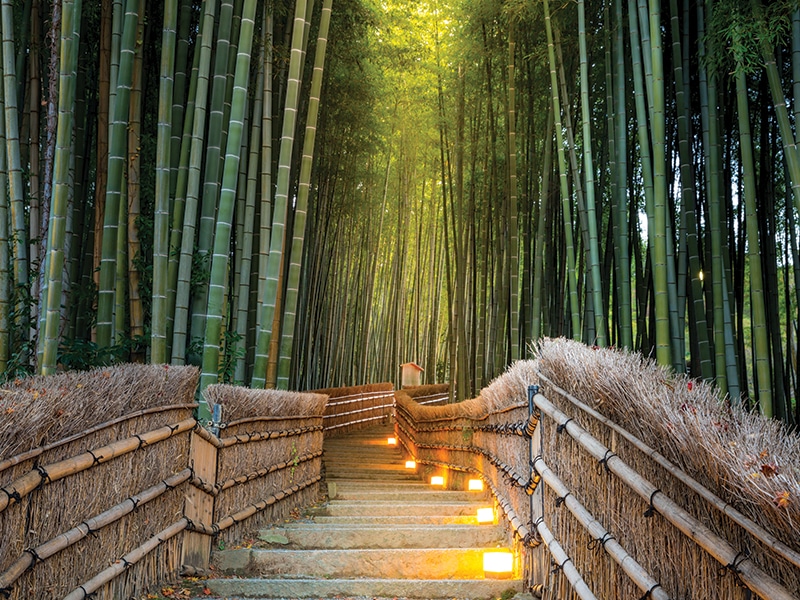Verne Maree went to Kyoto for its ancient architecture, glorious temples and working geisha district. But she was equally seduced by its great natural beauty, distinctive food culture and warm, friendly people.
It’s been fairly said that if you had time to visit just one Japanese city, that city should be Kyoto. Bounded by mountains to the west, north and east, and bifurcated by the Kamo River, it’s a manageable size and easy to navigate by public transport and by foot.
Arriving at the strikingly futuristic Kyoto Station, we’re met by our tireless guide, Miyazaki-san, a Kyotoite herself, whose first task is to get us to our hotel, The Westin Miyako. After that, she’s at our service for the afternoon and the next two days. It’s a great treat to get your nose out of the guidebook and listen to a real person. What’s more, nothing is too much trouble for Miya-san. Each morning, she presents us with a detailed itinerary of what we saw and did the day before, including the price of taxis and entry to sites, which – be warned – tend to mount up.
Three Temples, Two Shrines and a Castle
Situated on the lower slope of a mountain to the east of the city, our hotel is perfect for a leisurely walking tour of some of Kyoto’s most important sights.
Kiyomizu Temple
Kiyomizu Temple is most famous for the terrace off its main hall, supported by 139 wooden pillars and constructed without nails – a marvel of joinery. The endless school groups that climb up to and descend from the temple along a picturesque lane are well catered to by shops selling traditional sweets and ice cream cones in green tea or black sesame flavours.
Jishu Shrine
Right next to the temple is the jolly Jishu Shrine, a huge hit with young people as it’s dedicated to love and the God of Matchmaking – a sort of 15th century Cupid. Contrary to The Beatles’ opinion on the matter, it seems that money can buy love; or at least a lucky love charm. Interesting that it costs just 500 yen for a charm to “find a partner”, but 2,000 yen to “bind your love closer”.
Nanzenji Temple
It’s a pleasant hike from the hotel to the massive gates of Nanzenji Temple. However, we’re startled by the anachronistic appearance of an enormous and authentic-looking Roman aqueduct near the gates, until Miya-san explains that it was built in the late 19th century, after scholars visited Europe after the end of Japan’s self imposed Isolation Period (1625 to 1968). Other ideas they brought back with them included British-style school uniforms. And also – more up-to-date, certainly, and perhaps a tad more useful – driving on the left side of the road, the steam engine and the railway.
Ginkakuji Temple
From here, the pleasant mile-long Philosopher’s Walk winds across the mountain, past cosy-looking traditional houses and along a pretty little canal. It leads to Ginkakuji Temple, also known as the Silver Pavilion, which boasts a fine garden and steep stone steps up to a lovely view of Kyoto.
Heian Shrine
At the bright-orange-painted Chinese style Heian Shrine, a little girl glorious in kimono is celebrating her seventh birthday with proud parents and grandparents. Apparently, this is traditionally done on the third, fifth and seventh birthday.
Nijo Castle
Nijo Castle is a highlight of Kyoto. In the reception rooms of the stunning palace within its fortress walls are exquisite murals and tableaux of the shogun, with his female attendants or receiving the homage of feudal lords. We enjoy its “nightingale floors”, specially constructed to squeak and chirrup under the weight of a tiptoeing ninja spy, and evidence of the shogun’s paranoia.
After dark is the time to visit Hanamikoji Gion Kobi and Gion Shinbashi, genuine working geisha districts. Miya-san explains the signs nailed next to the doors of the traditional geisha houses: licence plates, the names of the geishas past and present, and other vital statistics. Entrance to them, or to the Ichiriki Tea House or Geisha Party House, is strictly by invitation only. She also points out a couple of geisha schools, which display their curricula on signs at the front.
All day, we’ve seen plenty of Japanese tourists dressed in kimonos hired for the day, but tonight we’re delighted to almost bump into just one apprentice geisha, or maiko, whose three-inch geita clatter on the cobbled lane as she hurries along.
Not keen on getting around on your own? Enjoy comfortable bus tour from Osaka to Kyoto.
Where to stay:
Our choice of The Westin Miyako Kyoto, a two-minute walk from Keage Station, proved a perfect complement to Kyoto’s cultural attractions. This grand old lady has hosted a slew of famous guests. In the 1920s Albert Einstein, the Rockefellers and Anna Pavlova. In the 1930s Charles Lindbergh, Douglas Fairbanks and Mary Pickford. Later Helen Keller, John Wayne, Twiggy, Andy Warhol, to name but a few. And of course more presidents, prime ministers and royalty than you can shake a sceptre at.
Getting there:
It’s an 80-minute train trip to Kyoto Station from Osaka’s Kansai Airport. If you’re coming from Tokyo, take the high-speed Shinkansen, which leaves at frequent intervals – so much more convenient than flying! Treat yourself to a pre-booked seat in a super comfortable first class Green Car. This costs 18,000 yen (about S$225) per person for a trip that takes about two hours and 10 minutes.
See more in our travel section
Stunning Koh Samui villa just four hours away







